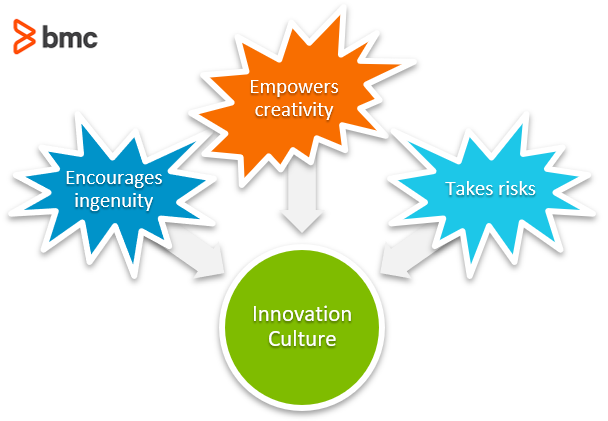Two things business leaders know: change is the only constant, and novel problems require novel solutions. The modern IT world is one built upon the successes of its predecessors—each new advancement comes on the back of innovation. Without innovation, organizations become stagnant. And stagnation is the death spiral to becoming obsolete.
In a world that moves as fast as the tech industry, standing still is like signing your own death warrant. Succeeding in the modern business world requires organizations to not only keep up, but set the tempo for the industry while making competitors fight to match them.
One of the key methods for achieving this kind of success is through fostering an innovation culture.
(This article is part of our Innovation in The Enterprise series. Use the right-hand menu to navigate.)
What is innovation culture?
Put simply, innovation culture is a business environment that promotes the generation of new ideas and methods. Innovation culture is about creating an atmosphere that:
- Encourages ingenuity
- Empowers creativity
- Understands the value of taking risks
Encouraging ingenuity
Encouraging ingenuity from your team will help you tap into a nearly limitless resource of new ideas. Ingenuity is any combination of being clever, inventive, or unique. In the workplace, ingenuity shows up when you ask questions like:
- Why do we do this process in this way?
- Would a process be better if we changed it?
But you can only utilize this resource to its fullest potential by establishing your organization as one that values input from all sources. Do you encourage people to ask these types of questions? How do you respond when they do?
Ingenuity is the foundation to creating a culture of innovation because you never know from where the next great idea may come. The concept here is that the more people who feel inspired to innovate, the greater the chance for finding that idea becomes.
Empowering creativity
Encouraging ingenuity is all about creating an environment where ideas are valued and everyone feels like their opinions are heard.
Empowering creativity is about taking the next step beyond ideation: moving forward with concrete plans for how those ideas can be put to action.
Innovation culture is about more than just posing what-if questions. It’s about taking those nascent ideas and forming them into actionable plans with realistic goals and timelines. It’s about:
- Building upon the ideas each person presents.
- Considering what the implementation of those concepts would look like.
(Explore strategies that can harness creativity, like design thinking or agility.)
Taking risks
For innovation culture to be truly successful, it’s imperative that the organization be willing to take new ideas and run with them. Not every idea will make it to this round, but some must. Of these, some will fail, and one or two might win.
Prototyping and testing new ideas is one of the best ways to get a practical handle on the viability of the new approach.
Taking risks and giving people room to fail is the only way to ensure that the people within your organization aren’t afraid of coming up with new ideas and putting them into action. Failure is an invaluable tool for learning, and this type of learning process is not one that should be ignored by organizations looking to maximize their potential.

Why is innovation culture important?
Our world has been changing at an ever-increasing rate. Stopping for even a moment runs the risk of being left miles behind everyone else.
Innovation is more than a buzzword—it’s the lifeblood of modern organizations. Companies like Amazon and Google are where they are today because of their near obsession with innovation. All the work they do is structured entirely around the process of coming up with new ideas and methods for improving on the old ones. Alphabet, Google’s parent company, reportedly spent a staggering $26 billion on R&D in 2019 alone. These guys don’t rest on their laurels.
Even with the massive success of services like Netflix and Twitter, these products are by no means secure in their positions atop their sectors.
New streaming services and social media platforms are springing up all the time as the innovations that made Netflix and Twitter into giants have become baseline expectations for customers across the globe. Modern consumers expect a lot from companies these days because companies have shown what can be achieved when combining technology with novel ideas.
The relationship that customers have with companies is similar in ways to the relationship between two spouses. While the initial honeymoon period may seem a portent of wondrous days ahead, eventually the focus will turn towards the “what have you done for me lately” mentality. This is especially true in the SaaS business model where customers subscribe to a service and therefore rightfully expect those services to be constantly improving.
How to build an innovation culture
We talked about how successful innovation cultures encourage ingenuity, empower creativity, and take risks. But creating an innovation culture requires more than lip service. Much like DevOps is more than a way of structuring teams, creating an innovation culture requires organizations to change the way they think and the policies they maintain.
It’s not enough to send out a memo and install a few suggestion boxes. Fostering an innovation culture requires the participation of everyone within the organization. Innovation can come from anywhere, and the only way to create an atmosphere where that can happen is by making everyone feel truly heard.
The key to enacting any changes is communication. Transparency and the breaking down of traditional hierarchies will empower everyone within your organization to take an active role in forging the future of the company. Questions to ask yourself and your organization:
- Are you supporting innovation through research & development?
- How does digital transformation incorporate innovation?
- Do you explicitly call out innovation efforts, perhaps through an innovation lab or innovation outpost?
- Do any roles focus on innovation, such as the Chief Transformation Officer?
Creating an innovation culture cannot be achieved by simply establishing someone as an “Innovation Guru” or by forming an “Innovation Team.” Ideas should flow freely throughout your organization and everyone should feel like a valued member of the team with a personal stake in the success of the organization.
People need to be provided with structure that supports the formulation of ideas while still having the freedom necessary to put them into action. Challenging the status quo requires risks to be taken and everyone within your organization should feel encouraged to test their new ideas. Failure should be anticipated but not punished as change rarely comes easily. This, however, doesn’t mean people shouldn’t be held accountable for their actions.
Accountability and personal responsibility are key factors for inspiring people to invest themselves into the future of the organization. If people have no sense of ownership over their work, they will be far less likely to meaningfully invest themselves in their role.
Related reading
- BMC Business of IT Blog
- The Innovation Trigger: An Idea Begins
- Applying Lean Startup Concepts in The Workplace
- Lewin’s 3 Stage Model of Change Explained
- Digital Transformation Metrics for Measuring Success
These postings are my own and do not necessarily represent BMC's position, strategies, or opinion.
See an error or have a suggestion? Please let us know by emailing blogs@bmc.com.






